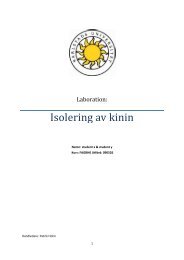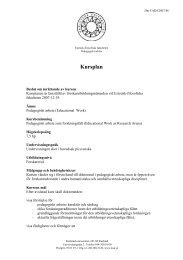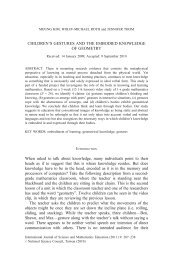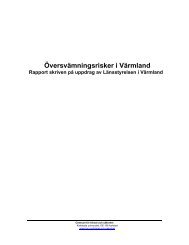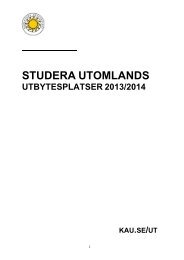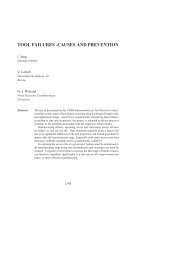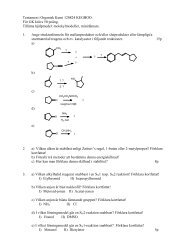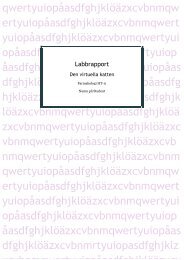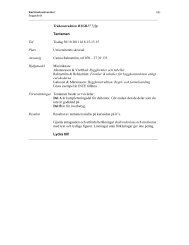Coupled reactions in glycolysis
Coupled reactions in glycolysis
Coupled reactions in glycolysis
Create successful ePaper yourself
Turn your PDF publications into a flip-book with our unique Google optimized e-Paper software.
<strong>Coupled</strong> <strong>reactions</strong> <strong>in</strong> <strong>glycolysis</strong><br />
1. Background and theory<br />
The aim of this exercise is to illustrate some of the <strong>reactions</strong> of <strong>glycolysis</strong> and how the<br />
thermodynamically unfavourable <strong>reactions</strong> can be driven by coupl<strong>in</strong>g to favourable<br />
<strong>reactions</strong>. In addition, the use of spectrophotometry to follow the formation or<br />
consumption of NADH is demonstrated.<br />
The <strong>reactions</strong> under study are:<br />
step 1 of <strong>glycolysis</strong>:<br />
step 6 of <strong>glycolysis</strong>:<br />
Glyceraldehyde -<br />
phosphate<br />
dehydrogenase<br />
(GAPDH)<br />
Glyceraldehyde - 3 - phosphate + P i<br />
+ NAD + ← ⎯⎯ ⎯⎯ ⎯⎯ ⎯⎯ ⎯⎯ ⎯⎯ →<br />
1,3 bisphosphoglycerate +NADH<br />
€<br />
step 7 of <strong>glycolysis</strong>:
In summary:<br />
The optical spectra of NAD + and NADH are shown <strong>in</strong> figure 1 below. The different<br />
spectra allow the monitor<strong>in</strong>g of the GAPDH reaction where NADH is formed, with<br />
subsequent <strong>in</strong>crease of the absorbance at 340 nm. The other <strong>reactions</strong> are followed<br />
<strong>in</strong>directly from their effect on the equilibrium position of the GAPDH reaction.<br />
If we, for example, start with a NAD + , GAP and phosphate, and <strong>in</strong>itiate the reaction by<br />
the addition of GAPDH, we will observe formation of NADH as the equilibrium is<br />
established. If Mg-ADP and PGK is added at this po<strong>in</strong>t, more NADH will be formed<br />
s<strong>in</strong>ce 1,3-PGA is consumed <strong>in</strong> the PGK reaction. The reaction stops when both equilibria<br />
are established. More details about the reaction mechanism of GAPDH and the<br />
thermodynamics of <strong>glycolysis</strong> <strong>in</strong> Lehn<strong>in</strong>ger , pp. 536 and 553.<br />
Figure 1. Optical spectra of NADH and NAD + . The molar absorptivity<br />
(ext<strong>in</strong>ction coefficient) of NADH at 340 nm is 6.22 x 10 3 M -1 cm -1<br />
(from Lehn<strong>in</strong>ger. P. 517)
2. Materials<br />
2.1 Equipment<br />
Spectrophotometer (preferably a double beam <strong>in</strong>strument) with recorder.<br />
1 ml quartz cuvette<br />
Pipettors<br />
2.2 Chemicals<br />
2.2.1 Solutions to be prepared by the student<br />
100 mM Tris-HCl pH 7.4 conta<strong>in</strong><strong>in</strong>g 0.5 mM EDTA 100 ml<br />
300 mM sodium phosphate buffer, pH 7.4 50 ml<br />
100 mM MgCl 2 (aqueous) 10 ml<br />
2 mM ADP <strong>in</strong> Tris buffer 10 ml<br />
2 mM NAD <strong>in</strong> Tris buffer 10 ml<br />
100 mM glucose (aqueous) 10 ml<br />
0.17 M Sodium arsenate, pH 8.5<br />
Tris buffer: Dissolve the calculated amounts of Tris and Na 2 EDTA <strong>in</strong> about 80 ml water,<br />
adjust pH to 7.4 with 5 M HCl (small additions when pH approaches the desired value)<br />
and dilute to 100 ml.<br />
Phosphate buffer: dissolve the calculated amount of NaH 2 PO 4 <strong>in</strong> 40 ml water and adjust<br />
pH to 7.4 with 5 M NaOH; dilute to 50 ml with water.
2.2.2 Solutions available<br />
about 30 mM D,L-glyceraldehyde phosphate<br />
(note that only the D-form serves as substrate!)<br />
about 70 µM glyceraldehyde phosphate dehydrogenase<br />
about 100 µM hexok<strong>in</strong>ase<br />
about 1 µM phosphoglyceratk<strong>in</strong>as<br />
GAP<br />
GAPDH<br />
HK<br />
PGK<br />
All solutions except the Tris buffer should be kept on ice
3. Procedure<br />
The <strong>reactions</strong> are monitored by the absorbance at 340 nm where NADH absorbs. Prepare<br />
the substrate mixture <strong>in</strong> the cuvette and place it <strong>in</strong> the spectrophotometer. Zero the<br />
<strong>in</strong>strument and start record<strong>in</strong>g. Record the base l<strong>in</strong>e a few m<strong>in</strong>utes, and then make<br />
additions as <strong>in</strong>dicated <strong>in</strong> the description of the experiments. Be careful to allow the<br />
reaction come to equilibrium after each addition (note that this can take up to 20 m<strong>in</strong>);<br />
note however that all additions do not result <strong>in</strong> a reaction. Be careful to mix the contents<br />
of cuvette after each addition. Always use a clean pipette tip to avoid any contam<strong>in</strong>ations<br />
of the reagents.<br />
Experiment 1<br />
As a starter, we <strong>in</strong>vestigate the complete reaction system. Set the <strong>in</strong>strument to a total<br />
record<strong>in</strong>g time of about 30 m<strong>in</strong> and set the scale to use 1 absorbance unit correspond<strong>in</strong>g<br />
full scale.<br />
Substrate<br />
Additions<br />
Tris Buffer 805 µl 1. GAPDH 25µl<br />
NAD 100 µl 2. PGK 10 µl<br />
Phosphate buffer 10 µl 3. HK 10 µl<br />
ADP 10 µl<br />
MgCl 2 50 µl<br />
Glucose 25 µl<br />
GAP 40 µl<br />
Then we change the order of the additions to be sure that the system works accord<strong>in</strong>g to<br />
the description.
Experiment 2<br />
Substrate<br />
Additions<br />
Tris Buffer 950 µl 1. GAPDH 25µl<br />
NAD 100 µl 2. PGK 10 µl<br />
Phosphate buffer 10 µl 3. HK 10 µl<br />
ADP 10 µl 4. Glucose 25 µl<br />
MgCl 2 50 µl<br />
GAP 40 µl<br />
Experiment 3 (change the scale to about 0.2 absorbance units full scale)<br />
Substrate<br />
Additions<br />
Tris Buffer 790 µl 1. GAPDH 25µl<br />
NAD 100 µl 2. PGK 10 µl<br />
Phosphate buffer 10 µl 3. MgCl 2 50 µl<br />
ADP 100 µl<br />
GAP 40 µl<br />
Experiment 4<br />
Substrate<br />
Additions<br />
Tris Buffer 790 µl 1. GAPDH 25µl<br />
NAD 100 µl<br />
Phosphate buffer 10 µl<br />
GAP 40 µl<br />
Arsenate 100 µl
4.<br />
Documentation and report<strong>in</strong>g<br />
All experimental work is to be recorded <strong>in</strong> the laboratory notebook by each student. Each<br />
group submits a summary of the observations <strong>in</strong> experiment 1-4 and a calculation of ∆G o '<br />
for the GAPDH-reaction (compare the result with the literature value <strong>in</strong> Lehr<strong>in</strong>ger<br />
table 14-2). Discuss briefly the effect of arsenate <strong>in</strong> experiment 4.<br />
The submission of a laboratory complete report will be assigned to some groups. The<br />
report should consist of the follow<strong>in</strong>g sections:<br />
- Summary<br />
- Introduction (background and aim with the experiments)<br />
- Materials and methods<br />
- Results<br />
- Discussion. This section should also <strong>in</strong>clude a summary of the results obta<strong>in</strong>ed by<br />
the other groups.



